Remediating Severely Salt-Affected Soil with Vermicompost and Organic Amendments for Cultivating Salt-Tolerant Crops as a Functional Food Source
Abstract
1. Introduction
2. Materials and Methods
2.1. Study Area
2.2. Preparation of Soil, Vermicompost, and Organic Amendments
2.3. Vermicompost Sampling and Analysis
2.4. Experimental Design
2.5. Soil Analyses
2.6. Growth and Biomass Attributes
2.7. Root Morphology Study
2.8. Flower Production and Nutrition Analysis
2.9. Statistical Analysis
3. Results
3.1. The Results of Using Vermicompost and Organic Amendments on Soil Salinity and Soil Physiochemical Properties
3.2. The Use of Vermicompost and Organic Amendment on the Growth of Sesbania in Severely Salt-Affected Soil
3.3. Nutritional Value of Sesbania rostrata Flower
4. Discussion
4.1. Vermicompost and Organic Amendments & Soil Salinity and Soil Physiochemical Properties
4.2. Vermicompost and Organic Amendments & Sesbania Growth and Biomass Attributes
4.3. Vermicompost and Organic Amendments & Sesbania Nutrition and Potential as a Functional Food Source
5. Conclusions
Author Contributions
Funding
Data Availability Statement
Acknowledgments
Conflicts of Interest
References
- FAO—Food and Agriculture Organization of the United Nations. The World Map of Salt Affected Soil. 2021. Available online: https://www.fao.org/soils-portal/data-hub/soil-maps-and-databases/global-map-of-salt-affected-soils/en/ (accessed on 10 April 2024).
- Arunin, S.; Pongwichian, P. Salt-affected Soils and Management in Thailand. Bull. Soc. Sea Water Sci. Jpn. 2015, 69, 319–325. [Google Scholar]
- Topark-ngarm, B. Saline Soil in Northest Thailand; Khon Kaen University Publisher: Khon Kaen, Thailand, 2006; pp. 15–25. [Google Scholar]
- Oo, A.N.; Iwai, C.B.; Saenjun, P. Soil properties and maize growth in saline and nonsaline soils using cassava-industrial waste compost and vermicompost with or without earthworms. Land Degrad. Dev. 2015, 26, 300–310. [Google Scholar] [CrossRef]
- Office of the Agricultural Economy. Area of Cultivated Per Rai and Agricultural Production of Thailand; Center of Agricultural Information, Ministry of Agriculture and Cooperatives Thailand: Bangkok, Thailand, 1998. [Google Scholar]
- Yuvaniyama, A.; Arunin, S.; Takai, Y. Management of saline soil in the Northeast of Thailand. Thai J. Agric. Sci. 1996, 29, 1–10. [Google Scholar]
- Eswaran, H.; Vearasilp, T.; Reich, P.; Beinroth, F. Sandy Soils of Asia: A New Frontier for Agricultural Development. In Proceedings of the Management of Tropical Sandy Soils for Sustainable Development, Proceedings of the International Conference on the Management of Tropical Sandy Soils, Khon Kaen, Thailand, 27 November–2 December 2005; FAO Regional Office for Asia and the Pacific: Bangkok, Thailand, 2005. [Google Scholar]
- Kabaki, N.; Tamura, H.; Yoshihashi, T.; Miura, K.; Tabuchi, R.; Fujumori, S.; Morita, H.; Wungkashart, T.; Watanatitawas, P.; Uraipong, B.; et al. Development of a Sustainable Lowland Cropping System in Northeast Thailand. In Proceedings of the Development of Sustainable Agricultural System in Northeast Thailand through Local Resource Utilization and Technology Improvement, Khon Kaen, Thailand, 6–7 February 2002. Jircas working report No. 30. 2003. [Google Scholar]
- Hasegawa, P.M.; Bressan, R.A.; Zhu, J.K.; Bohnert, H.J. Plant cellular and molecular responses to high salinity. Annu. Rev. Plant Physiol. Plant Mol. Biol. 2000, 51, 463–499. [Google Scholar] [CrossRef]
- Lu, Y.; Fricke, W. Salt Stress-Regulation of Root Water Uptake in a Whole-Plant and Diurnal Context. Int. J. Mol. Sci. 2023, 24, 8070. [Google Scholar] [CrossRef]
- Purbajanti, E.; Kusmiyati, F.; Fuskhah, E. Growth, Yield and Physiological Characters of Three Types of Indonesian Rice Under Limited Water Supply. Asian J. Plant Sci. 2017, 16, 101–108. [Google Scholar] [CrossRef]
- Doan, T.T.; Bouvier, C.; Bettarel, Y.; Bouvier, T.; Henry-des-Tureaux, T.; Janeau, J.L.; Lamballe, P.; Nguyen, B.V.; Jouquet, P. Influence of buffalo manure, compost, vermicompost and biochar amendments on bacterial and viral communities in soil and adjacent aquatic systems. Appl. Soil Ecol. 2014, 73, 78–86. [Google Scholar] [CrossRef]
- Wu, Y.; Li, Y.; Zheng, C.; Zhang, Y.; Sun, Z. Organic amendment application influence soil organism abundance in saline alkali. Eur. J. Soil. Biol. 2013, 54, 32–40. [Google Scholar] [CrossRef]
- Yu, H.; Zou, W.; Chen, J.; Chen, H.; Yu, Z.; Huang, J.; Tang, H.; Wei, X.; Gao, B. Biochar amendment improves crop production in problem soils: A review. J. Environ. Manag. 2019, 232, 8–21. [Google Scholar] [CrossRef]
- Song, X.; Li, H.; Song, J.; Chen, W.; Shi, L. Biochar/vermicompost promotes Hybrid Pennisetum plant growth and soil enzyme activity in saline soils. Plant Physiol Biochem. 2022, 183, 96–110. [Google Scholar] [CrossRef]
- Tejada, M.; Gonzalez, J.L.; Garcia-Martinez, A.M.; Parrado, J. Effects of different green manures on soil biological properties and maize yield. Bioresour. Technol. 2008, 99, 1758–1767. [Google Scholar] [CrossRef] [PubMed]
- Land Development Department. Distribution of Salt Affected Soil in the Northeast Region 1:100,000 Map; Department of Land Development: Bangkok, Thailand, 1991. [Google Scholar]
- Bremner, J.M. Total Nitrogen. In Methods of Soil Analysis: Part 2 Chemical and Microbiological Properties, 9.2; Norman, A.G., Ed.; American Society of Agronomy: Madison, WI, USA, 1965; pp. 1149–1178. [Google Scholar]
- Petmuenwai, N.; Iwai, C.B.; Srihaban, P.; Kume, T. Utilizing vermicompost and agricultural waste for sesbania rostrata cultivation on salt-affected soil in greenhouse conditions. Khon Kaen Agric. J. 2024, 52, 341–351. [Google Scholar]
- AOAC. Official Methods of Analysis of the Association of Official Analytical Chemists: Official Methods of Analysis of AOAC International, 21st ed.; AOAC: Washington, DC, USA, 1970. [Google Scholar]
- Sheppard, B.S.; Heitkemper, D.T.; Gaston, C.M. Microwave digestion for the determination of arsenic, cadmium and lead in seafood products by inductively coupled plasma atomic emission and mass spectrometry. Analyst 1994, 119, 1683–1686. [Google Scholar] [CrossRef]
- Schierle, J.; Pietsch, B.; Ceresa, A.; Fizet, C.; Waysek, E.H. Method for the determination of beta-carotene in supplements and raw materials by reversed-phase liquid chromatography: Single laboratory validation. J. AOAC Int. 2004, 87, 1070–1082. [Google Scholar] [CrossRef] [PubMed]
- Ding, Z.; Kheir, A.M.S.; Ali, O.A.M.; Hafez, E.M.; ElShamey, E.A.; Zhou, Z.; Wang, B.; Lin, X.; Ge, Y.; Fahmy, A.E.; et al. A vermicompost and deep tillage system to improve saline-sodic soil quality and wheat productivity. J. Environ. Manag. 2021, 277, 111388. [Google Scholar] [CrossRef] [PubMed]
- Liu, M.; Wang, C.; Liu, X.; Lu, Y.; Wang, Y. Saline-alkali soil applied with vermicompost and humic acid fertilizer improved macroaggregate microstructure to enhance salt leaching and inhibit nitrogen losses. Appl. Soil Ecol. 2020, 156, 103705. [Google Scholar] [CrossRef]
- Goswami, L.; Nath, A.; Sutradhar, S.; Bhattacharya, S.S.; Kalamdhad, A.; Vellingiri, K.; Kim, K.H. Application of drum compost and vermicompost to improve soil health, growth, and yield parameters for tomato and cabbage plants. J. Environ. Manag. 2017, 200, 243–252. [Google Scholar] [CrossRef] [PubMed]
- Yang, L.; Zhao, F.; Chang, Q.; Li, T.; Li, F. Effects of vermicomposts on tomato yield and quality and soil fertility in greenhouse under different soil water regimes. Agric. Water Manag. 2015, 160, 98–105. [Google Scholar] [CrossRef]
- Liu, S.; Meng, J.; Jiang, L.; Yang, X.; Lan, Y.; Cheng, X.; Chen, W. Rice husk biochar impacts soil phosphorous availability, phosphatase activities and bacterial community characteristics in three different soil types. Appl. Soil Ecol. 2017, 116, 12–22. [Google Scholar] [CrossRef]
- Ch’ng, H.Y.; Ahmed, O.H.; Majid, N.M.A.; Jalloh, M.B. Reducing Soil Phosphorus Fixation to Improve Yield of Maize on a Tropical Acid Soil Using Compost and Biochar Derived from Agro-Industrial Wastes. Compos. Sci. Util. 2017, 25, 82–94. [Google Scholar] [CrossRef]
- Baliah, T. Effect of Microbially Enriched Vermicompost on the Growth and Biochemical Characteristics of Okra (Abelmoschus Esculentus (L.) moench). Adv. Plants Agric. Res. 2017, 6, 10. [Google Scholar] [CrossRef][Green Version]
- Oladele, S.O.; Adeyemo, A.J.; Awodun, M.A. Influence of rice husk biochar and inorganic fertilizer on soil nutrients availability and rain-fed rice yield in two contrasting soils. Geoderma 2019, 336, 1–11. [Google Scholar] [CrossRef]
- Arancon, N.; Edwards, C.A.; Peter, M.B.; Christie, W.; James, D.M. Influences of vermicomposts on field strawberries: 1. Effects on growth and yields. Bioresour. Technol. 2004, 93, 145–153. [Google Scholar] [CrossRef] [PubMed]
- Canellas, L.P.; Fabio, L.O.; Anna, L.O.F.; Arnoldo, R.F. Humic acids isolated from earthworm compost enhance root elongation, lateral root emergence, and plasma membrane H+-ATPase activity in maize roots. Plant Physiol. 2002, 130, 1951–1957. [Google Scholar] [CrossRef] [PubMed]
- Chaoui, H.I.; Zibilske, L.M.; Ohno, T. Effects of earthworm casts and compost on soil microbial activity and plant nutrient availability. Soil Biol. Biochem. 2003, 35, 295–302. [Google Scholar] [CrossRef]
- Diacono, M.; Montemurro, F. Effectiveness of Organic Wastes as Fertilizers and Amendments in Salt-Affected Soils. Agriculture 2015, 5, 221–230. [Google Scholar] [CrossRef]
- Phuong, N.T.K.; Khoi, C.M.; Ritz, K.; Linh, T.B.; Minh, D.D.; Duc, T.A.; Sinh, N.V.; Linh, T.T.; Toyota, K. Influence of rice husk biochar and compost amendments on salt contents and hydraulic properties of soil and rice yield in salt-affected fields. Agronomy 2020, 10, 1101. [Google Scholar] [CrossRef]
- Zhu, F.; Huang, N.; Xue, S.; Hartley, W.; Li, Y.; Zou, Q. Effects of binding materials on microaggregate size distribution in bauxite residues. Environ. Sci. Pollut. Control Ser. 2016, 23, 23867–23875. [Google Scholar] [CrossRef]
- Lakhdar, A.; Rabhi, M.; Ghnaya, T.; Montemurro, F.; Jedidi, N.; Abdelly, C. Effectiveness of compost use in salt-affected soil. J. Hazard Mater. 2009, 171, 29–37. [Google Scholar] [CrossRef] [PubMed]
- Feng, Y.; Sun, H.; Xue, L.; Liu, Y.; Gao, Q.; Lu, K.; Yang, L. Biochar applied at an appropriate rate can avoid increasing NH3 volatilization dramatically in rice paddy soil. Chemosphere 2017, 168, 1277–1284. [Google Scholar] [CrossRef]
- Cooper, J.; Greenberg, I.; Ludwig, B.; Hippich, L.; Fischer, D.; Glaser, B.; Kaiser, M. Effect of biochar and compost on soil properties and organic matter in aggregate size fractions under field conditions. Agric. Ecosyst. Environ. 2020, 295, 106882. [Google Scholar] [CrossRef]
- Xu, L.; Yan, D.; Ren, X.; Wei, Y.; Zhou, J.; Zhao, H.; Liang, M. Vermicompost improves the physiological and biochemical responses of blessed thistle (Silybum marianum Gaertn.) and peppermint (Mentha Haplocalyx Briq) to salinity stress. Ind. Crop. Prod. 2016, 94, 574–585. [Google Scholar] [CrossRef]
- Ghassemi-Golezani, K.; Farhangi-Abriz, S. Biochar-based metal oxide nanocomposites of magnesium and manganese improved root development and productivity of safflower (Carthamus tinctorius L.) under salt stress. Rhizosphere 2021, 19, 100416. [Google Scholar] [CrossRef]
- Farhangi-Abriz, S.; Torabian, S. Antioxidant enzyme and osmotic adjustment changes in bean seedlings as affected by biochar under salt stress. Ecotoxicol. Environ. Saf. 2017, 137, 64–70. [Google Scholar] [CrossRef] [PubMed]
- He, K.; He, G.; Wang, C.; Zhang, H.; Xu, Y.; Wang, S.; Kong, Y.; Zhou, G.; Hu, R. Biochar amendment ameliorates soil properties and promotes Miscanthus growth in a coastal saline-alkali soil. Appl. Soil Ecol. 2020, 155, 103674. [Google Scholar] [CrossRef]
- Zheng, H.; Wang, X.; Chen, L.; Wang, Z.; Xia, Y.; Zhang, Y.; Wang, H.; Luo, X.; Xing, B. Enhanced growth of halophyte plants in biochar-amended coastal soil: Roles of nutrient availability and rhizosphere microbial modulation. Plant Cell Environ. 2018, 41, 517–532. [Google Scholar] [CrossRef] [PubMed]
- Zhang, M.; Zhang, L.; Riaz, M.; Xia, H.; Jiang, C. Biochar amendment improved fruit quality and soil properties and microbial communities at different depths in citrus production. J. Clean. Prod. 2021, 292, 126062. [Google Scholar] [CrossRef]
- Azadi, N.; Raiesi, F. Sugarcane bagasse biochar modulates metal and salinity stresses on microbial functions and enzyme activities in saline co-contaminated soils. Appl. Soil Ecol. 2021, 167, 104043. [Google Scholar] [CrossRef]
- Singh, P.; Garg, S.; Satpute, S.; Singh, A. Use of Rice Husk Ash to Lower the Sodium Adsorption Ratio of Saline Water. Int. J. Curr. Microbiol. Appl. Sci. 2017, 6, 448–458. [Google Scholar] [CrossRef]
- Lopez, M.J.; Peralbo, A.; Flores, F. Closed soilless growing system: A sustainable solution for strawberry crop in Huelva (Spain). Acta Hortic. 2004, 649, 213–215. [Google Scholar] [CrossRef]
- Abad, M.; Noguera, P.; Puchades, R.; Maquieira, A.; Noguera, V. Physico-chemical and chemical properties of some coconut coir dusts for use as a peat substitute for containerised ornamental plants. Bioresour. Technol. 2002, 82, 241–245. [Google Scholar] [CrossRef] [PubMed]
- Rubio, J.S.; Rubio, F.; Martínez, V.; García-Sánchez, F. Amelioration of salt stress by irrigation management in pepper plants grown in coconut coir dust. Agric. Water Manag. 2010, 97, 1695–1702. [Google Scholar] [CrossRef]
- Kyriacou, M.; Youssef, R. Towards a new definition of quality for fresh fruits and vegetables. Sci. Hortic. 2007, 234, 463–469. [Google Scholar] [CrossRef]
- Quinet, M.; Angosto, T.; Yuste-Lisbona, F.J.; Blanchard-Gros, R.; Bigot, S.; Martinez, J.P.; Lutts, S. Tomato Fruit Development and Metabolism. Front. Plant Sci. 2019, 10, 1554. [Google Scholar] [CrossRef] [PubMed]
- Ruangjanda, S.; Iwai, C.B.; Greff, B.; Chang, S.W.; Ravindran, B. Valorization of spent mushroom substrate in combination with agro- residues to improve the nutrient and phytohormone contents of vermicompost. Environ. Res. 2022, 214, 113771. [Google Scholar] [CrossRef]
- Juleel, R.; Ashraf, K.; Sultan, K.; Deng, G.; Rehman, M.; Siddiqui, M.H.; Zaman, Q. Soil applied vermicompost improves morphophysio-biochemical and quality attributes of lettuce under saline conditions. South Afr. J. Bot. 2023, 161, 499–511. [Google Scholar]
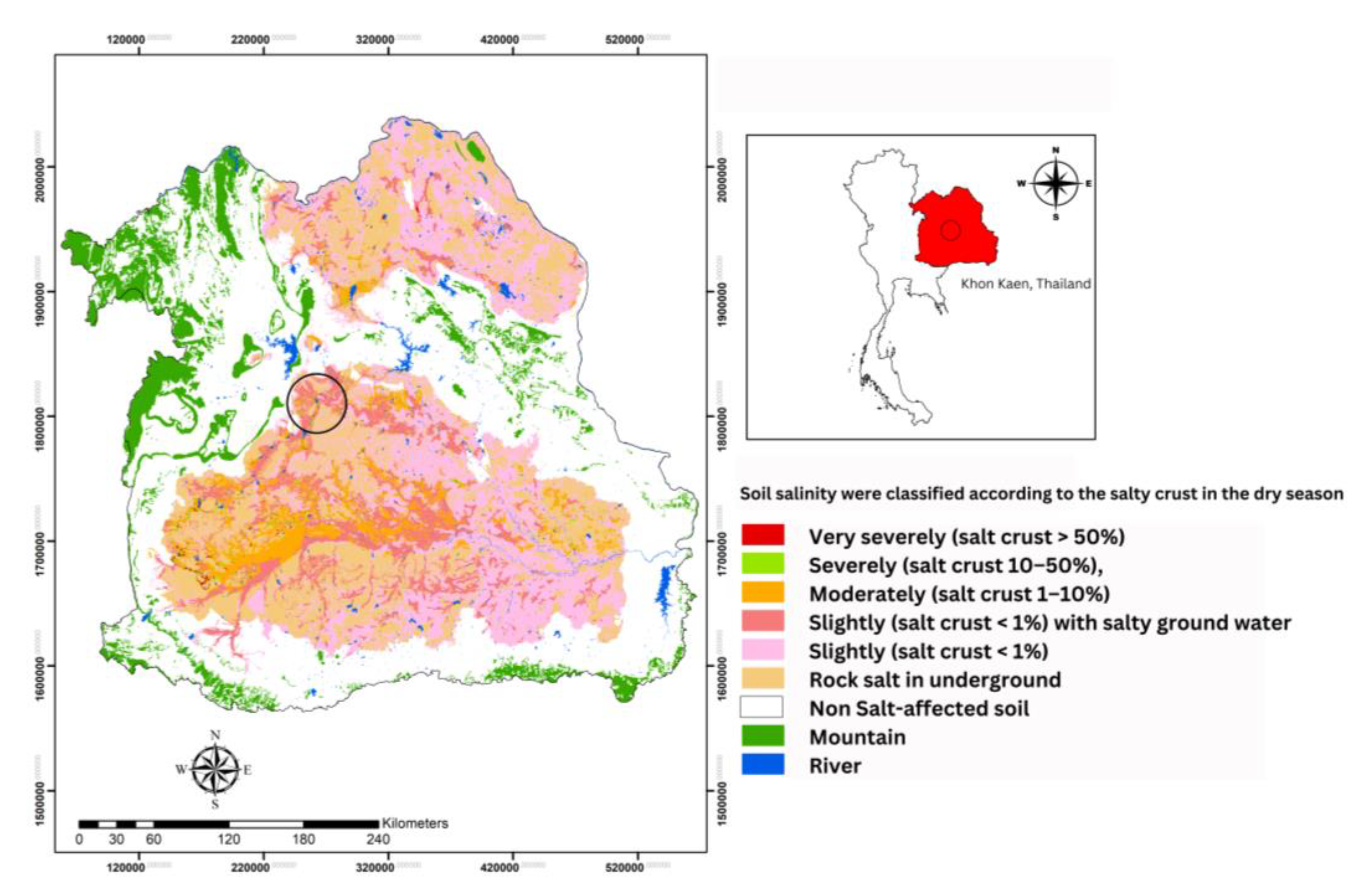
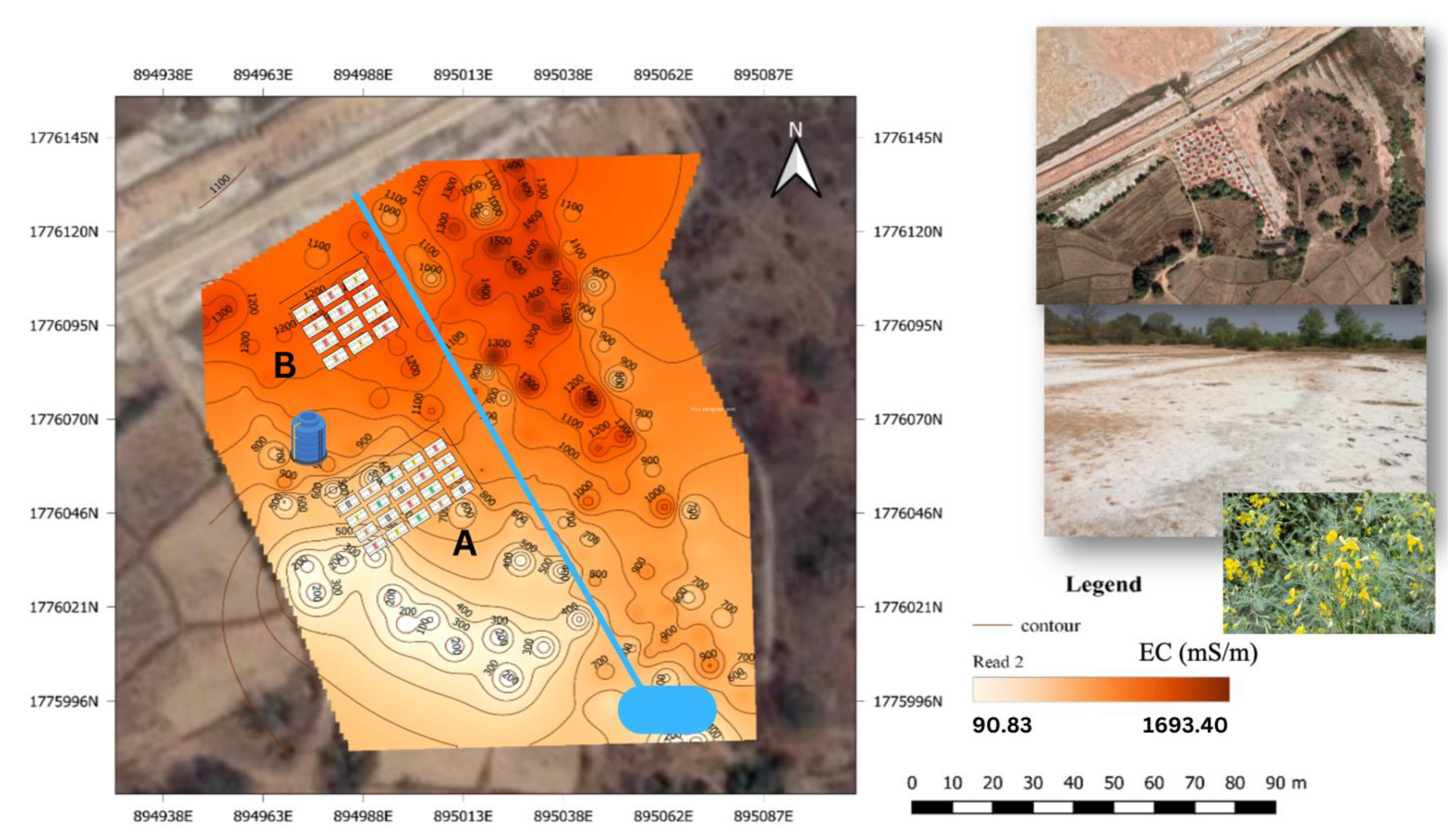
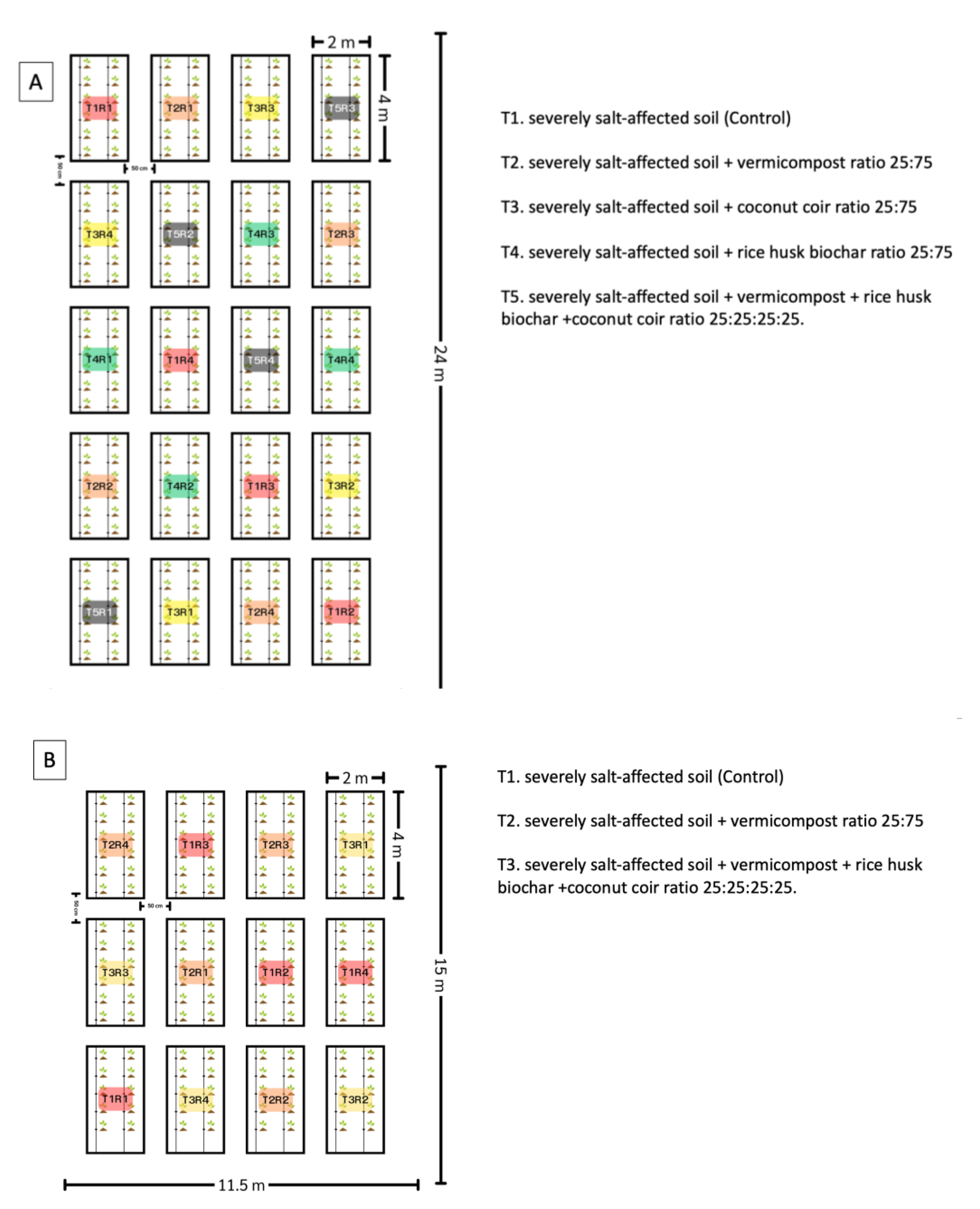
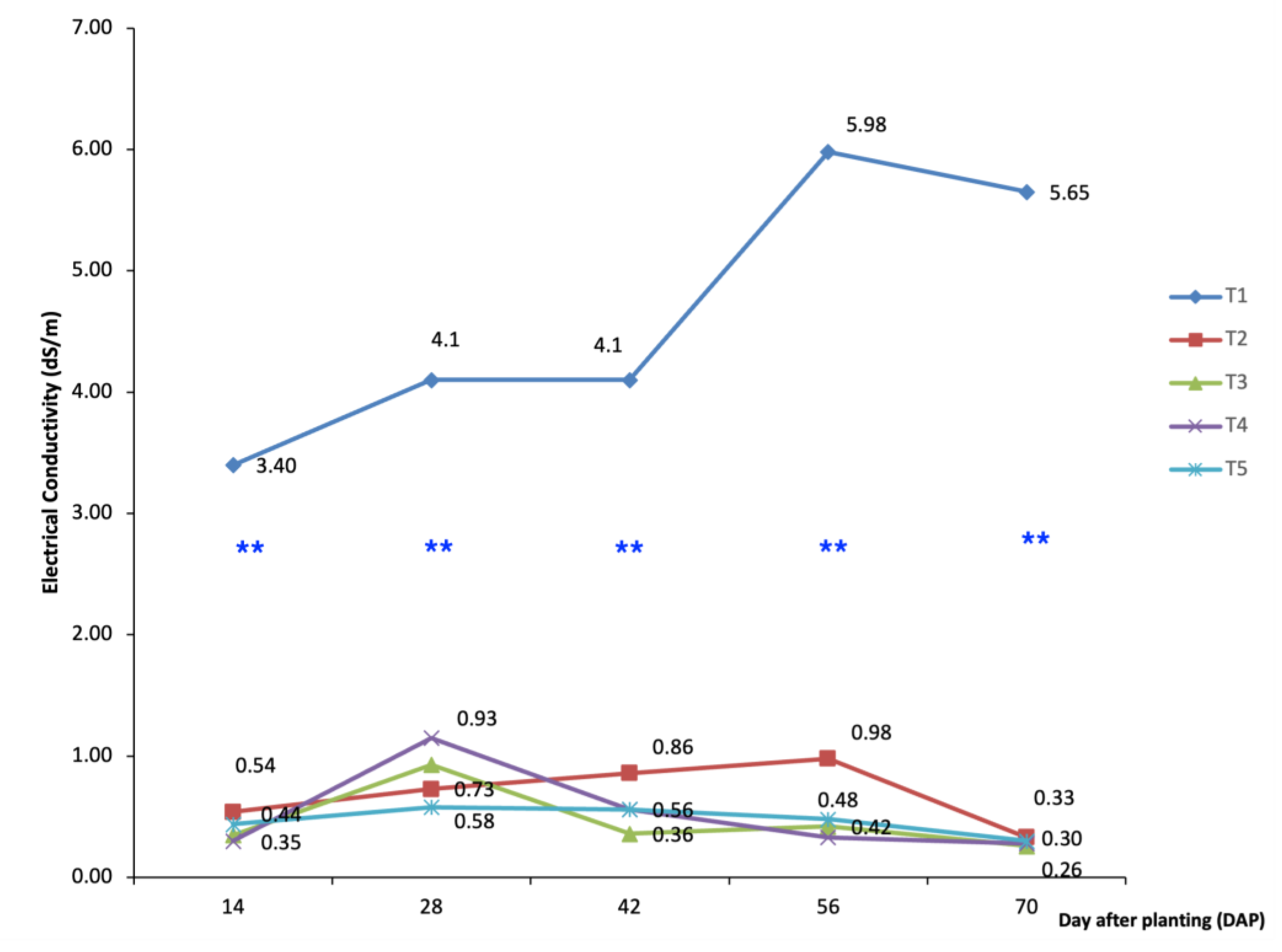

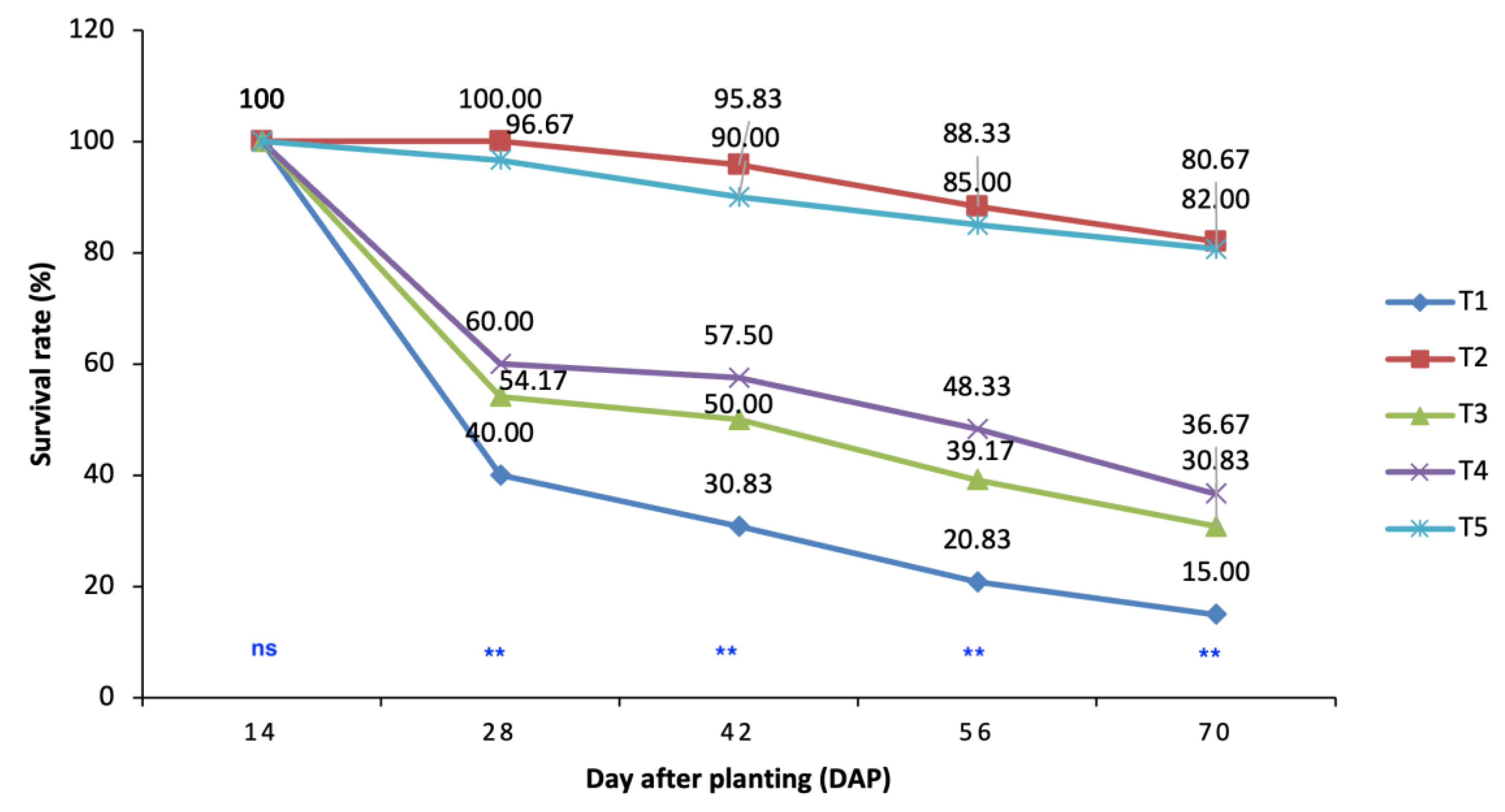
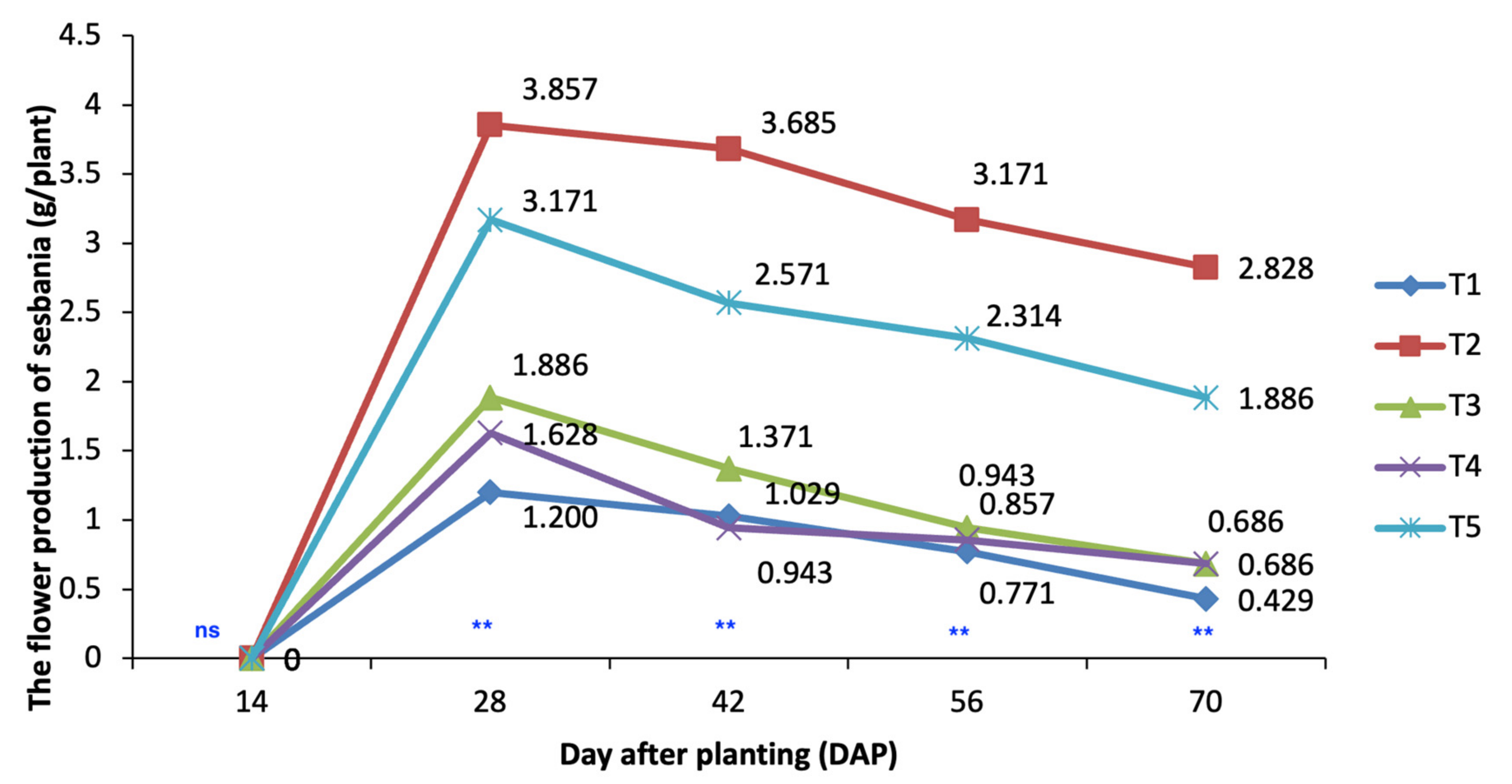
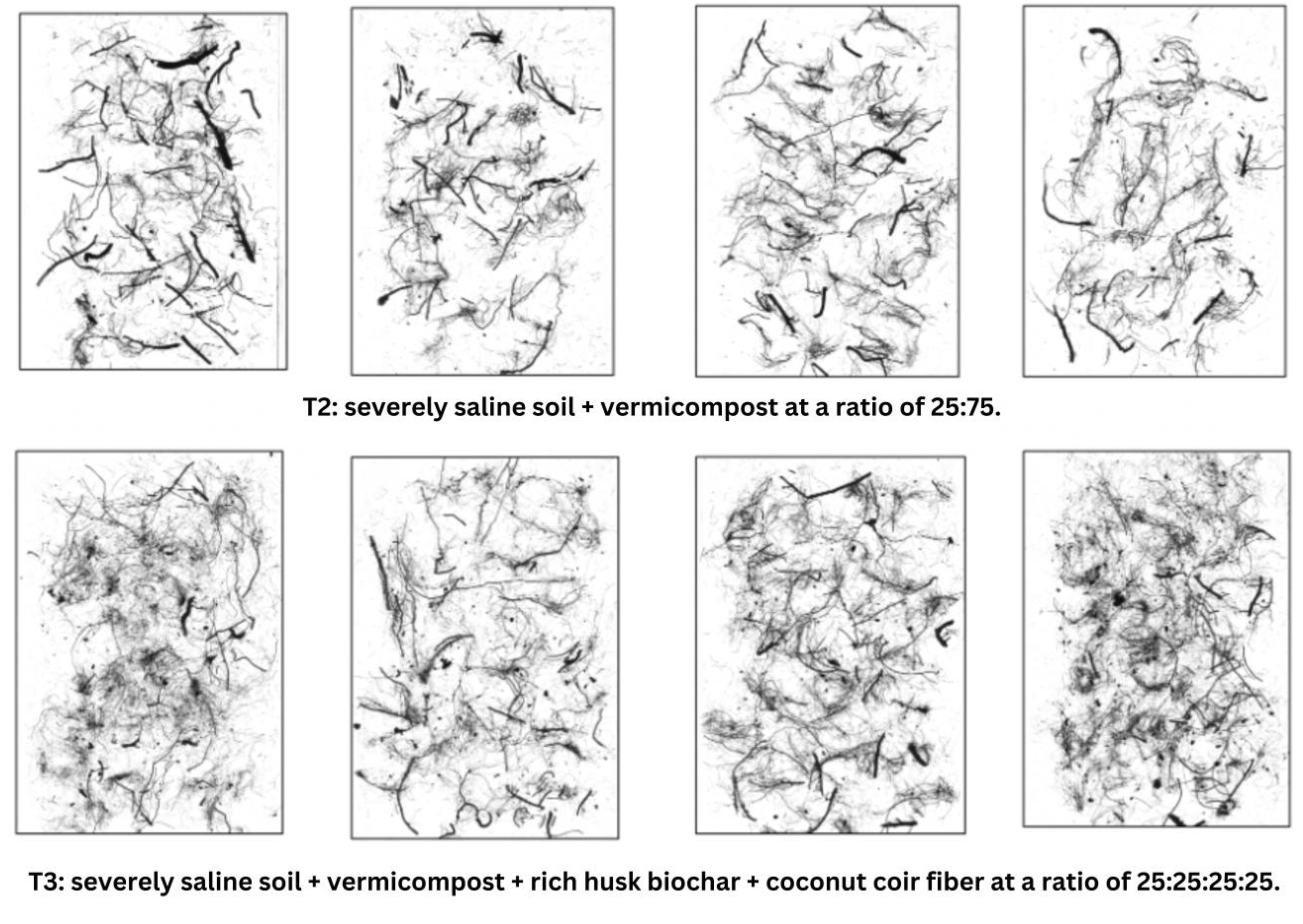

| Parameter | Bedding Materials | Vermicompost | Coconut Coir | Rice Husk Biochar |
|---|---|---|---|---|
| pH (1:10) | 7.99 ± 0.04 | 7.61 ± 0.01 | 5.50 ± 0.22 | 9.80 ± 0.67 |
| EC (dS/m) | 1.268 ± 0.01 | 1.68 ± 0.01 | 3.70 ± 0.08 | 1.64 ± 0.09 |
| Organic carbon (%) | 13.01 ± 0.01 | 16.37 ± 0.09 | 75.5 ± 2.65 | 46.40 ± 1.12 |
| Total nitrogen (%) | 1.38 ± 0.12 | 2.40 ± 0.01 | 0.24 ± 0.06 | 0.54 ± 0.11 |
| Total phosphorus (%) | 1.42 ± 0.02 | 4.70 ± 0.00 | 0.09 ± 0.02 | 0.20 ± 0.02 |
| Total potassium (g/kg) | 2.85 ± 0.01 | 4.10 ± 0.01 | 1.70 ± 0.03 | 0.73 ± 0.03 |
| C/N ratio | 29.65 ± 0.59 | 12.32 ± 0.49 | 77.00 ± 1.83 | 53.50 ± 1.29 |
| Treatment | pH | EC dS/m | OM (%) | N (%) | P (ppm) | Exchangeable | |||
|---|---|---|---|---|---|---|---|---|---|
| K | Na | Ca | Mg | ||||||
| Cmol/kg | |||||||||
| T1 saline soil (control) | 5.63 c | 3.11 a | 1.86 b | 0.09 b | 6.49 d | 0.22 c | 1.580 a | 9.79 a | 3.20 a |
| T2 saline soil + vermicompost (25:75) | 6.65 a | 0.33 bc | 5.96 a | 0.30 a | 55.00 a | 0.66 a | 0.003 b | 0.04 b | 0.01 b |
| T3 saline soil + coconut coir (25:75) | 6.00 b | 0.40 b | 6.56 a | 0.33 a | 36.00 c | 0.43 b | 0.01 b | 0.04 b | 0.01 b |
| T4 saline soil + rice husk biochar (25:75) | 6.70 a | 0.26 c | 3.31 b | 0.17 b | 47.00 b | 0.62 a | 0.003 b | 0.04 b | 0.01 b |
| T3 saline soil + vermicompost + biochar from rice husk + coconut coir (25:25:25:25) | 6.48 a | 0.28 c | 5.68 a | 0.29 a | 43.00 b | 0.51 ab | 0.004 b | 0.03 b | 0.01 b |
| F-test | ** | ** | ** | ** | ** | ** | ** | ** | ** |
| CV (%) | 1.86 | 5.51 | 19.39 | 19.05 | 26.32 | 14.63 | 14.6 | 20.53 | 11.68 |
| Treatment | pH | EC dS/m | OM (%) | N (%) | P (ppm) | Exchangeable | |||
|---|---|---|---|---|---|---|---|---|---|
| K | Na | Ca | Mg | ||||||
| Cmol/kg | |||||||||
| T1 saline soil (Control) | 5.35 d | 3.59 a | 1.93 d | 0.10 d | 6.65 c | 0.25 b | 2.46 a | 11.31 a | 3.04 a |
| T2 saline soil + vermicompost (25:75) | 6.93 bc | 0.44 bc | 6.45 bc | 0.32 bc | 39.00 b | 0.23 b | 1.27 bc | 0.14 b | 0.03 b |
| T3 saline soil + coconut coir (25:75) | 7.68 a | 0.35 bc | 5.85 c | 0.29 c | 34.00 b | 0.30 b | 1.04 c | 0.11 b | 0.03 b |
| T4 saline soil + rice husk biochar (25:75) | 6.60 c | 0.54 b | 9.25 ab | 0.46 ab | 44.00 a | 0.44 a | 1.44 b | 0.15 b | 0.05 b |
| T3 saline soil + vermicompost + biochar from rice husk + coconut coir (25:25:25:25) | 7.23 ab | 0.30 c | 10.45 a | 0.52 a | 41.00 b | 0.29 b | 1.40 b | 0.13 b | 0.05 b |
| F-test | ** | ** | ** | ** | ** | ** | ** | ** | ** |
| CV (%) | 3.88 | 9.75 | 19.43 | 19.39 | 61.15 | 20.35 | 10.29 | 35.57 | 10.59 |
| DAP | Electrical Conductivity (dS/m) | |||||||||
|---|---|---|---|---|---|---|---|---|---|---|
| Treatment | 14 | 28 | 42 | 56 | 70 | 84 | 98 | 112 | 126 | |
| T1 saline soil (control) | 3.67 a | 6.21 a | 6.23 a | 11.39 a | 11.48 a | 13.82 a | 16.88 a | 8.27 a | 9.64 a | |
| T2 saline soil + vermicompost 25:75 | 0.39 b | 0.73 b | 0.55 b | 1.06 b | 0.87 b | 0.60 b | 0.48 b | 0.66 b | 0.71 b | |
| T3 saline soil + vermicompost + biochar from rice husk + coconut coir 25:25:25:25 | 0.51 b | 0.50 b | 0.59 b | 0.68 b | 0.47 b | 0.80 b | 0.32 b | 0.73 b | 0.79 b | |
| F-test | ** | ** | ** | ** | ** | ** | ** | ** | ** | |
| CV (%) | 8.04 | 8.20 | 8.65 | 7.05 | 6.39 | 7.23 | 8.82 | 7.13 | 7.01 | |
| Treatment | pH | EC dS/m | OM (%) | N (%) | P (ppm) | Exchangeable | |||
|---|---|---|---|---|---|---|---|---|---|
| K | Na | Ca | Mg | ||||||
| Cmol/kg | |||||||||
| T1 saline soil (control) | 6.63 b | 16.23 a | 1.36 b | 0.07 b | 2.43 a | 0.15 b | 80.50 a | 12.96 b | 1.55 b |
| T2 saline soil + vermicompost 25:75 | 6.93 ab | 8.73 b | 7.95 a | 0.40 a | 5.80 b | 0.32 a | 11.97 b | 17.45 a | 4.66 a |
| T3 saline soil + vermicompost + biochar from rice husk + coconut coir 25:25:25:25 | 7.18 a | 6.01 b | 6.65 a | 0.33 a | 5.00 b | 0.34 a | 25.88 b | 21.05 a | 3.44 a |
| F-test | * | ** | ** | ** | ** | * | ** | ** | ** |
| CV (%) | 3.31 | 8.84 | 8.02 | 6.28 | 7.63 | 8.44 | 7.11 | 6.57 | 9.51 |
| Treatment | pH | EC dS/m | OM (%) | N (%) | p (ppm) | Exchangeable | |||
|---|---|---|---|---|---|---|---|---|---|
| K | Na | Ca | Mg | ||||||
| Cmol/kg | |||||||||
| T1 saline soil (control) | 6.53 | 15.26 a | 1.24 b | 0.06 b | 2.50 b | 0.14 b | 79.6 a | 17.45 b | 2.70 b |
| T2 saline soil + vermicompost 25:75 | 6.98 | 1.12 b | 12.43 a | 0.62 a | 5.60 a | 0.70 a | 11.9 b | 22.96 a | 3.35 b |
| T3 saline soil + vermicompost + biochar from rice husk + coconut coir 25:25:25:25 | 6.70 | 1.96 b | 7.42 ab | 0.37 ab | 6.30 a | 0.60 a | 25.8 b | 21.05 ab | 6.67 a |
| F-test | ns | ** | * | * | * | ** | ** | ** | ** |
| CV (%) | 3.61 | 8.82 | 8.46 | 8.42 | 7.82 | 8.17 | 7.03 | 8.13 | 8.58 |
| DAP | Height (cm) | |||||||||
|---|---|---|---|---|---|---|---|---|---|---|
| Treatment | 14 | 28 | 42 | 56 | 70 | 84 | 98 | 112 | 126 | |
| T1 saline soil (Control) | 10.25 | 0.00 b | 0.00 b | 0.00 b | 0.00 b | 0.00 b | 0.00 b | 0.00 c | 0.00 c | |
| T2 saline soil+ vermicompost 25:75 | 10.25 | 18.75 a | 50.75 a | 65.25 a | 74.50 a | 79.45 a | 87.00 b | 88.50 b | 88.50 b | |
| T3 saline soil+ vermicompost + biochar from rice husk +coconut coir 25:25:25:25 | 10.25 | 18.25 a | 52.25 a | 73.38 a | 75.50 a | 78.00 a | 94.50 a | 94.50 a | 94.50 a | |
| F-test | ns | ** | ** | ** | ** | ** | ** | ** | ** | |
| CV (%) | 5.10 | 11.31 | 10.79 | 11.37 | 11.39 | 11.83 | 10.23 | 9.81 | 9.81 | |
| DAP | Percent of Survival (%) | |||||||||
|---|---|---|---|---|---|---|---|---|---|---|
| Treatment | 14 | 28 | 42 | 56 | 70 | 84 | 98 | 112 | 126 | |
| T1 saline soil (control) | 100.00 | 0.00 b | 0.00 b | 0.00 b | 0.00 b | 0.00 b | 0.00 b | 0.00 b | 0.00 b | |
| T2 saline soil+ vermicompost 25:75 | 100.00 | 100.00 a | 100.00 a | 100.00 a | 80.00 b | 71.60 b | 71.60 b | 66.70 b | 66.70 b | |
| T3 saline soil+ vermicompost + biochar from rice husk +coconut coir 25:25:25:25 | 100.00 | 100.00 a | 100.00 a | 100.00 a | 91.60 a | 88.30 a | 88.30 a | 83.30 a | 83.30 a | |
| F-test | ns | ** | ** | ** | ** | ** | ** | ** | ** | |
| CV (%) | 0.00 | 0.00 | 0.00 | 0.00 | 12.91 | 12.89 | 12.89 | 15.71 | 15.71 | |
| DAP | Flower per Plant (gram) | |||||||||
|---|---|---|---|---|---|---|---|---|---|---|
| Treatment | 14 | 28 | 42 | 56 | 70 | 84 | 98 | 112 | 126 | |
| T1 saline soil (control) | 0.00 | 0.00 | 0.00 c | 0.00 c | 0.00 c | 0.00 | 0.00 | 0.00 | 0.00 | |
| T2 saline soil + vermicompost 25:75 | 0.00 | 0.00 | 2.70 b | 3.80 b | 2.40 b | 0.00 | 0.00 | 0.00 | 0.00 | |
| T3 saline soil + vermicompost + biochar from rice husk +coconut coir 25:25:25:25 | 0.00 | 0.00 | 3.90 a | 4.20 a | 3.80 a | 0.00 | 0.00 | 0.00 | 0.00 | |
| F-test | ns | ns | ** | ** | ** | ns | ns | ns | ns | |
| CV (%) | 0.00 | 0.00 | 5.85 | 3.06 | 8.98 | 0.00 | 0.00 | 0.00 | 0.00 | |
| Treatment | Length (cm) | Surface Area (cm2) | AvgDiam (mm) | RootVolume (cm3) |
|---|---|---|---|---|
| T1 saline soil (control) | 0.00 c | 0.00 c | 0.00 c | 0.00 |
| T2 saline soil + vermicompost 25:75 | 1816.39 b | 214.39 b | 0.49 b | 2.04 b |
| T3 saline soil + vermicompost + biochar from rice husk + coconut coir 25:25:25:25 | 4961.95 a | 496.19 a | 0.56 a | 3.98 a |
| F-test | ** | ** | ** | ** |
| CV (%) | 8.60 | 8.14 | 7.68 | 9.05 |
| Treatment | Fresh Biomass | Dry Biomass |
|---|---|---|
| g/Plant | ||
| T1 saline soil (control) | 0.00 b | 0.00 b |
| T2 saline soil + vermicompost 25:75 | 66.62 a | 29.81 a |
| T3 saline Soil + vermicompost + biochar from rice husk + coconut coir 25:25:25:25 | 66.07 a | 29.60 a |
| F-test | ** | ** |
| CV (%) | 7.16 | 5.71 |
| Nutritional Value | Flower | ||
|---|---|---|---|
| Grown in Vermicompost and Organic Amendments | Grown in Normal Soil | Unit | |
| Protein | 3.60 | 3.35 | g/100 g |
| Total carbohydrate | 8.15 | 5.60 | g/100 g |
| Total fat | 0.47 | 0.40 | g/100 g |
| Calcium (Ca) | 337.70 | 51.00 | mg/kg |
| Iron (Fe) | 13.96 | 8.20 | mg/kg |
| Phosphorus(P) | 528.60 | 56.00 | mg/kg |
| Dietary fiber | 5.78 | 3.90 | g/100 g |
| Vitamin A (B-Carotene) | 427.56 | 34.30 | ug/100 g |
| Vitamin B1 (Thiamine) | 0.22 | 10.20 | mg/100 g |
| Vitamin B2 | 0.04 | 0.33 | mg/100 g |
| Vitamin B3 (Niacin) | 0.02 | 2.80 | mg/100 g |
| Vitamin C | 0.04 | 24.00 | mg/100 g |
| Zinc (Zn) | 3.69 | ND | mg/kg |
| Iron (Fe) | 56.24 | ND | mg/kg |
| Selenium (Se) | ND | ND | mg/kg |
| Silicon (Si) | 24.40 | ND | mg/kg |
Disclaimer/Publisher’s Note: The statements, opinions and data contained in all publications are solely those of the individual author(s) and contributor(s) and not of MDPI and/or the editor(s). MDPI and/or the editor(s) disclaim responsibility for any injury to people or property resulting from any ideas, methods, instructions or products referred to in the content. |
© 2024 by the authors. Licensee MDPI, Basel, Switzerland. This article is an open access article distributed under the terms and conditions of the Creative Commons Attribution (CC BY) license (https://creativecommons.org/licenses/by/4.0/).
Share and Cite
Petmuenwai, N.; Srihaban, P.; Kume, T.; Yamamoto, T.; Iwai, C.B. Remediating Severely Salt-Affected Soil with Vermicompost and Organic Amendments for Cultivating Salt-Tolerant Crops as a Functional Food Source. Agronomy 2024, 14, 1745. https://doi.org/10.3390/agronomy14081745
Petmuenwai N, Srihaban P, Kume T, Yamamoto T, Iwai CB. Remediating Severely Salt-Affected Soil with Vermicompost and Organic Amendments for Cultivating Salt-Tolerant Crops as a Functional Food Source. Agronomy. 2024; 14(8):1745. https://doi.org/10.3390/agronomy14081745
Chicago/Turabian StylePetmuenwai, Nattakit, Pranee Srihaban, Takashi Kume, Tadao Yamamoto, and Chuleemas Boonthai Iwai. 2024. "Remediating Severely Salt-Affected Soil with Vermicompost and Organic Amendments for Cultivating Salt-Tolerant Crops as a Functional Food Source" Agronomy 14, no. 8: 1745. https://doi.org/10.3390/agronomy14081745
APA StylePetmuenwai, N., Srihaban, P., Kume, T., Yamamoto, T., & Iwai, C. B. (2024). Remediating Severely Salt-Affected Soil with Vermicompost and Organic Amendments for Cultivating Salt-Tolerant Crops as a Functional Food Source. Agronomy, 14(8), 1745. https://doi.org/10.3390/agronomy14081745






